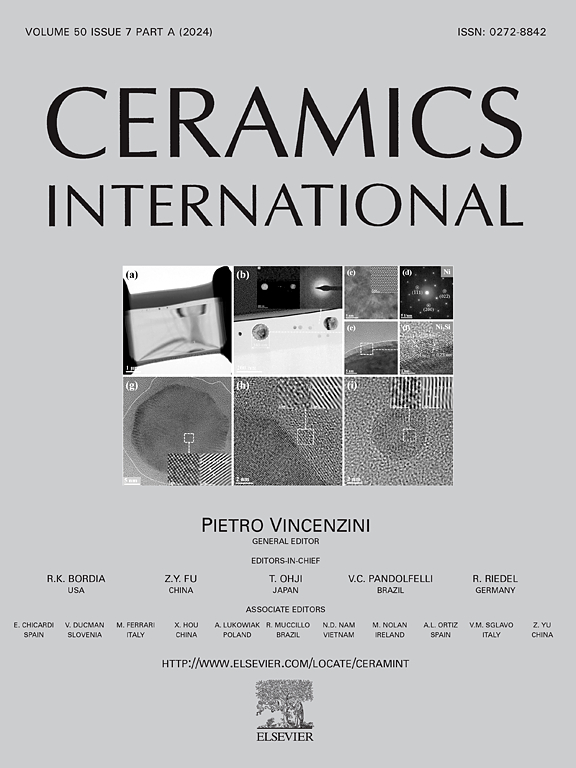硬质无裂纹tic基陶瓷的增材制造
IF 5.6
2区 材料科学
Q1 MATERIALS SCIENCE, CERAMICS
引用次数: 0
摘要
硬tic基陶瓷的增材制造通常采用高能光束作为能量源,但存在高残余应力和微裂纹。本文提出了一种采用粉末挤压印刷(PEP)和无压烧结相结合的经济的tic基陶瓷增材制造工艺,克服了广泛的残余应力和微裂纹等不足。成功地制造了高密度复杂金属陶瓷零件,从而从实验上证明了该方法的可行性。制备的TiC60(Ni88Fe12)40复合材料具有典型的核-环结构,对提高界面结合能力起着重要作用。烧结温度对微观组织和力学性能有显著影响。在1390 ~ 1430℃范围内,材料的抗弯强度和显微硬度先升高后降低。在1410°C时获得最佳力学性能,弯曲强度和显微硬度分别为1013±17 MPa和965±18 HV0.2。添加剂制备的陶瓷具有良好的耐磨性,其磨蚀机制主要为黏着磨损伴氧化磨损。良好的耐磨性是由于TiC相的高硬度和磨屑的润滑作用。本文章由计算机程序翻译,如有差异,请以英文原文为准。
Additive manufacturing of hard and crack-freeTiC-based cermets
Additive manufacturing of hard TiC-based cermets typically employs a high-energy beam as the energy source but suffers from high residual stress and microcracks. Herein, we propose an economical additive-manufacturing process for TiC-based cermets using powder extrusion printing (PEP) combined with pressureless sintering, which overcomes inadequacies such as extensive residual stress and microcracks. Complex cermet parts with high densities are successfully fabricated, thereby experimentally demonstrating the feasibility of this method. The as-produced TiC60(Ni88Fe12)40 composites exhibit a typical core-rim structure, which plays an important role in improving the interfacial bonding ability. The sintering temperature has a significant impact on the microstructure and mechanical properties. The flexural strength and microhardness increase first and then decrease at temperatures ranging from 1390 to 1430 °C. Optimum mechanical properties are achieved at 1410 °C with flexural strength and microhardness of 1013 ± 17 MPa and 965 ± 18 HV0.2, respectively. The additive-manufactured cermets exhibit superior abrasive resistance and the main abrasive mechanism is adhesive wear accompanied by oxidative wear. The good wear resistance is attributed to the high hardness of the TiC phase and the lubricating effect of the abrasive debris.
求助全文
通过发布文献求助,成功后即可免费获取论文全文。
去求助
来源期刊

Ceramics International
工程技术-材料科学:硅酸盐
CiteScore
9.40
自引率
15.40%
发文量
4558
审稿时长
25 days
期刊介绍:
Ceramics International covers the science of advanced ceramic materials. The journal encourages contributions that demonstrate how an understanding of the basic chemical and physical phenomena may direct materials design and stimulate ideas for new or improved processing techniques, in order to obtain materials with desired structural features and properties.
Ceramics International covers oxide and non-oxide ceramics, functional glasses, glass ceramics, amorphous inorganic non-metallic materials (and their combinations with metal and organic materials), in the form of particulates, dense or porous bodies, thin/thick films and laminated, graded and composite structures. Process related topics such as ceramic-ceramic joints or joining ceramics with dissimilar materials, as well as surface finishing and conditioning are also covered. Besides traditional processing techniques, manufacturing routes of interest include innovative procedures benefiting from externally applied stresses, electromagnetic fields and energetic beams, as well as top-down and self-assembly nanotechnology approaches. In addition, the journal welcomes submissions on bio-inspired and bio-enabled materials designs, experimentally validated multi scale modelling and simulation for materials design, and the use of the most advanced chemical and physical characterization techniques of structure, properties and behaviour.
Technologically relevant low-dimensional systems are a particular focus of Ceramics International. These include 0, 1 and 2-D nanomaterials (also covering CNTs, graphene and related materials, and diamond-like carbons), their nanocomposites, as well as nano-hybrids and hierarchical multifunctional nanostructures that might integrate molecular, biological and electronic components.
 求助内容:
求助内容: 应助结果提醒方式:
应助结果提醒方式:


